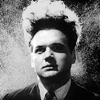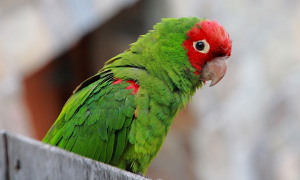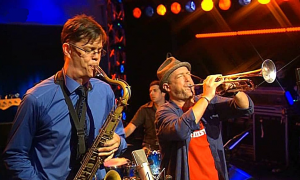Home » Jazz Articles » Genius Guide to Jazz » The Further Adventures of Duke Danger
The Further Adventures of Duke Danger
As the frenzy grew, promoter George Wein actually feared a riot and tried to stop the performance. Duke wouldn't hear of it (he was wearing ear muffs to ward off the cool Newport evening), and let Gonsalves continue for 27 choruses.
That said.
When last we left Duke Ellington , he had come into his own (I know what you're thinking. Stop it) as a composer and was constantly traversing the country with his ensemble. He had begun his remarkably productive collaboration with Billy Strayhorn, was firmly established among the top of the jazz hierarchy, and could now eat his own weight in manzanilla olives in a single sitting.
There is no reason whatsoever you should need to know that.
The forties saw Duke solidify his reputation as a serious composer first by removing the big floppy shoes and red rubber nose he had previously worn while composing (he stated that 'being in touch with his clown side' enhanced his creativity. He was successfully treated for this delusion with shock treatment [seeing Bessie Smith naked]), then by premiering extended compositions at Carnegie Hall and the Metropolitan Opera House of Pancakes.
Strike the 'of Pancakes' part of that last sentence, although there were telltale remnants of boysenberry syrup found on several of his manuscript from that era. I stand by my research.
The fifties began with the departure of longtime drummer Sonny Greer, as a result of a dispute over whether or not 'exacerbate' was a naughty word. Johnny Hodges, another veteran, also briefly left the group in pursuit of his dream of giving R&B chanteuse Etta James a hickey. But the real problem in the fifties was the decline in popularity of big band music. The new genre of rock-and-roll was exploding onto the scene, an energetic clarion call for post-war America that now positioned itself as the rebellious voice of a new generation much the way jazz had three decades before. Despite the manifold similarities between jazz and rock-and-roll, the two forms could not seem to reconcile their differences to work together to defeat the saccharine pop music that seems to survive like cockroaches from age to age. Thus, we never got to enjoy the spectacle of Louis Armstrong and Chuck Berry cornering Pat Boone in a dark alley.
Be that as it may.
Certainly, the first part of the fifties were rough for Duke. Touring constantly, but subsidized by earnings from Duke's compositions, they played everything from high school proms to Carnegie Hall (Duke would later confess that, while the proms had better punch, he had more chance of getting some leg at 'The Hall'). It wasn't until 1956, at the Newport Jazz Festival, that things turned around for Our Hero.
What happened at Newport is one of those rare moments in history whose truth exceeds legend. Duke finished an acceptable set with the custom-composed Newport Festival Suite , which brought the crowd to its feet and heading for the exits. Not willing to go gently into that good night (used by permission of Dylan Thomas, who owes me '40), Duke called for an old favorite, Diminuendo and Crescendo in Blue. Perhaps it was the moment, perhaps it was an instance of kismetic destiny, perhaps it was a contact buzz from the backstage festivities of off-duty musicians, but as Paul Gonsalves stood up to play his solo, jazz history was made. As Gonsalves began to play, a woman in the audience was overcome by the rhythm and stood up to dance. Her enthusiasm was infectious, inciting both Gonsalves and the crowd. Duke recognized a moment when he saw one, and kept Gonsalves playing. As the frenzy grew, promoter George Wein actually feared a riot and tried to stop the performance. Duke wouldn't hear of it (he was wearing ear muffs to ward off the cool Newport evening), and let Gonsalves continue for 27 choruses.
Duke and his orchestra came away from Newport rejuvenated, emboldened, and still basking in the golden glow that surrounded them as word of their triumph spread across the nation. Offers poured in, everything from gigs to recording sessions to product endorsements. Duke was even offered the opportunity to host the hit TV show Death Valley Days , which he declined. The gig went to Ronald Reagan, and the rest is history.
I may be thinking of John Wayne again, but to hell with it. We're too far along to turn back now.
Through the sixties Duke continued touring, taking the group to Europe and the Middle East frequently. He also continued recording, and showed a remarkable creativity for an artist of his age. It is my considered opinion (and remember, I am a Genius) that most creative personalities tend to wane in their later years, becoming either pale imitations of their former selves or graphic displays of the disintegration of their past greatness. Duke avoided this, remaining innovative and consistently surprising to his last days. Recordings with Louis Armstrong, John Coltrane, and an unlikely alliance with emerging stars Max Roach and Charles Mingus proved that Duke was still a vital artist.
If Louis Armstrong is the Father of Jazz, then Duke is the Godfather. In his music, he makes us an offer we can't refuse. We must go the mattresses in order to fully appreciate him, leave the gun and take the cannoli in order to understand his depthless genius, and never ask him about his business (or is that Godfather II ?).
At any rate.
If we have learned nothing else over these past couple of months, it is that Duke Ellington was worthy of the elaborate praise heaped upon him by Ken '20 Hours About Anything' Burns, and that his place in American music transcends mere popularity and exceeds category. Whereas Armstrong defined the soloists place in jazz, Ellington made a place for every musician within the confines of what is considered jazz. His legacy is that of brilliant inclusion, of synthesis and symbiosis, a statement of undeniable cogence to an indefinable art. And I'll fight the man who says different.
So then.
We'll wrap up this first month of the New Year by wishing everyone a happy and prosperous New Year. May you have every gift and blessing these twelve months have to offer, and may you have your best year ever in 2003. Now, if you'll excuse me, I've got a cold bottle of Pinot Grigio and a warm 'berblonde to attend to. Special greetings to my friends in Saltillo, Mexico; Northampton, England; and Bangalore, India. And Genius fans around the world, please don't hesitate to e-mail me and win valuable prizes.
Till next month, kids, exit to your right and enjoy the rest of AAJ.
< Previous
January 2003
Next >
Come Away With Me
Comments
Tags
For the Love of Jazz
 All About Jazz has been a pillar of jazz since 1995, championing it as an art form and, more importantly, supporting the musicians who create it. Our enduring commitment has made "AAJ" one of the most culturally important websites of its kind, read by hundreds of thousands of fans, musicians and industry figures every month.
All About Jazz has been a pillar of jazz since 1995, championing it as an art form and, more importantly, supporting the musicians who create it. Our enduring commitment has made "AAJ" one of the most culturally important websites of its kind, read by hundreds of thousands of fans, musicians and industry figures every month.























